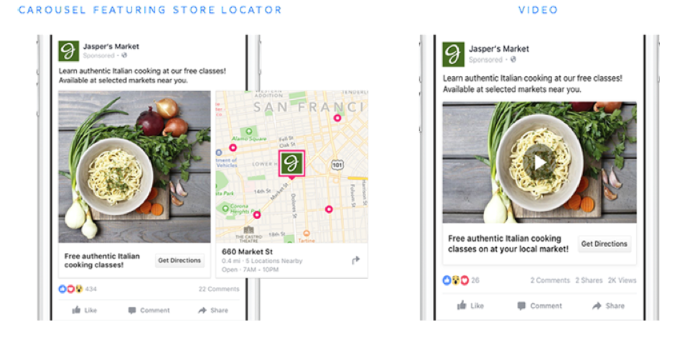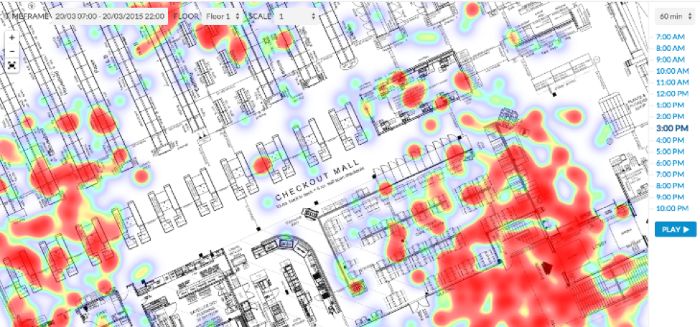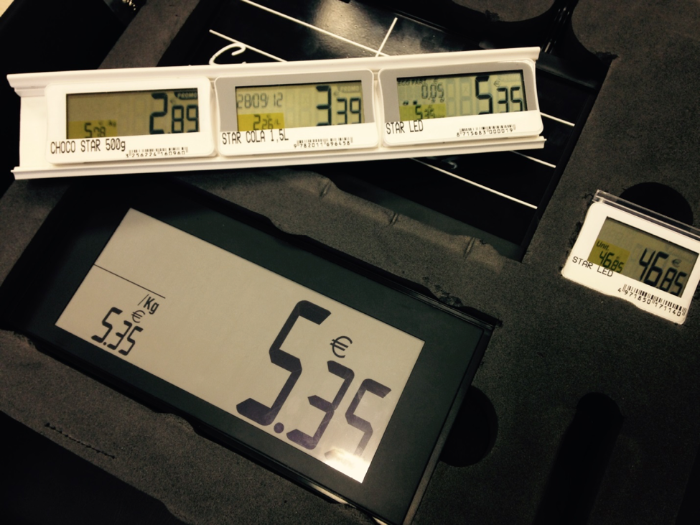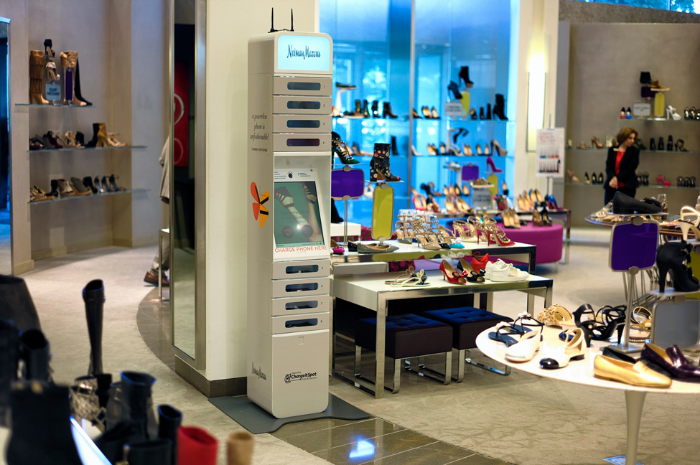How stores attract customers with technology: 7 effective tools

The retail sector is famous for fierce competition, therefore, retail chains are constantly working to attract new customers to their stores. Often, technologies of varying degrees of innovation are successfully used to solve this problem. In our today's material - 7 effective technological tools, with the help of which buyers are lured into stores abroad and in Russia.
Digital advertising on desktop and mobile
According to statistics from Deloitte, spending 64 cents from every dollar spent in offline stores is the result of exposure to digital advertising. In addition, according to Google’s own information , 76% of people who carry out a local search for nearby stores come to sales outlets within 24 hours, and 28% of such search queries result in a purchase.
')
That is why offline stores and retailers are looking for so-called points of contact with the audience on the Internet. Business seeks to maximize its online presence in order to be visible to a potential buyer at the moment when it needs the goods sold in the company's stores.
Example, the girl has ended mascara. Perhaps she planned not just to buy a new one, but to change the manufacturer or purchase a product that could give the best result and which would be enough for a longer time. The study of information on possible options can occur from the phone. When a potential buyer makes a short list of products of different brands, then follow the reviews and make the final decision - and the purchase can be made both from the desktop and already offline.
At the same time, according to Google, the conversion rate of American retailers on desktops is two times higher compared to the mobile segment. This is due to the fact that many stores have bad mobile versions of sites. As you know, 29% of smartphone users leave sites or applications that do not meet their needs - that is, those who take too long to load or where it is difficult to find information.
Therefore, many retailers are working on mobile versions of their resources. For example, the company Walmart increased conversion by 2%, reducing the loading time of a mobile site by four seconds.
Local marketing
With the help of various digital tools, retailers can use geo-tracking technologies to remind potential customers about their stores. Local advertisements can be displayed to the user in search engines or social networks .

In addition, geolocation can be used for targeted mailing coupons for a discount to those users who are close to the store. Such sudden discounts or promotions are effective "bait" for buyers - up to 50% of customers are more likely to enter the store if they receive a mobile coupon.
Flexible Pricing Technologies
Some large retailers are developing Big Data technologies - they can also be used for flexible pricing. For example, Amazon, which actively goes offline and opens its own points of sale, allows buyers to scan the prices of goods using the application — this gives them the opportunity to make sure that their value in the Amazon physical store is not higher than on the website. In addition, analyzing the frequency of such requests, the company understands the demand for certain goods, and also reveals the price level that will allow to maintain profitability and increase sales.
In addition, the company also analyzes how certain books are sold in the regions compared to the entire country, and uses online advertising methods to “align” the indicators.
Big Data technologies can also be used to solve other problems, such as combating deception by personnel. For example, data analysis helps to identify anomalies in the conduct of scoring operations on loyalty cards - if a seller has more such operations than his colleagues, then he should pay close attention. So you can catch employees who earn points on their own cards. This type of fraud brings real losses to stores, so fighting it is always a priority for retailers.
In our practice, there have also been cases when trade networks used Big Data approaches to select the location of outlets. If you rent a room in a bad place, then the number of buyers will decrease significantly.
This can be avoided by analyzing geo-data - for example, temperature maps of cellular providers, which show the activity of movement of residents of a particular locality. For example, after identifying activity in the Metro Elektrozavodskaya metro area from 09:00 to 19:00 for housewives aged 30 to 50 years, it is worth thinking about opening a store in this area aimed at this audience.

This method is also useful for stores that are located inside shopping malls - there are already various software tools that allow you to make heat maps of popular customer routes inside the mall.
Beacon
Beacon technology was called one of the most important for retail since the advent of mobile bank card readers . "Beacons" are small beacons located in the store that can recognize the buyer's smartphone and send information about promotions or discount coupons to it. Retailer marketers use beacons to attract customers and encourage shopping.
For example, using an application as part of a loyalty program, you can determine when a person is in the area of a beacon. At this point, the system sends a request to attract a customer to the store's CRM system. In response to the buyer's smartphone, a notification of a short-term bonus is received, for example, an additional discount, if he visits the store within two hours and makes a purchase in it.
This technology has existed for many years, but is constantly evolving. For example, not so long ago, Google developed an open platform for working with beacon called Eddystone. It allows you to integrate beacons with various Google services, like Nearby Notifications . This service helps Android smartphone users learn about interesting places nearby.
Companies are already beginning to experiment with a bunch of similar services and beacons - the opening opportunities attract not only retailers. For example, in 2015, United Airlines integrated Beacon and Nearby notification service. This was done in order to help passengers at the airport to better prepare for the flight - among other things, they were shown alerts reminding you to install a special application with entertainment during the flight.
Google conducted a study with 10 of the largest US retailers, including Target and Bed Bath & Beyond. It turned out that, on average, the number of repeated visits to the store under the influence of online advertising exceeded the number of online orders. A re-visit was considered a trip to the store, which would not have happened without online advertising. Beacons help improve the effectiveness of such hikes and contribute to better “detectability” of stores.
Electronic price tags and digital panels
Electronic price tags (EC) are displays of various sizes that display information about the product and its price, and sometimes additional data. The technology of electronic price tags appeared abroad about 20 years ago, it is used by many large European retailers. In Russia, the process of implementing them in stores was legally simplified only in 2016, but in a short time only a few players conducted pilot system implementations and were satisfied with the results.
At first glance, it seems that these digital displays do a maximum to help shops save on consumables when printing paper price tags. But in fact it is a great tool to attract customers.

Equipped with such displays, the store gains an advantage in price wars with competitors working in the old-fashioned way using paper. In the grocery retail sector, when using the second approach, it is very difficult to hold promotions often - that is why well-known magazines and newspapers with a product listing with discounts appear in stores no more than once a week.
In the case of traditional paper price tags, it is not so easy to reduce the prices of a group of goods after a competitor - at least a week will be spent on preparing new price tags in stores, as well as printing marketing materials. When using electronic price tags you can make changes within one day. Thus, by quickly repeating the proposals of a nearby competitor, you can negate the efforts of its marketers and drag customers to themselves.
In addition, when using electronic price tags, the store gets the opportunity to conduct “peak hour” actions, when the price of a product is valid only for a certain time. With paper price tags to hold such actions, in fact, is impossible, and the use of electronic allows you to easily change the price during the day and attract buyers.
Electronic price tags add more personalization to the process of "mobilization" of retail. Many of these displays are equipped with NFC-modules - like most smartphones (for example, this technology is widely implemented in the Hanshow price tags). So the price tag can interact with the phone, which was nearby.
For example, if an application is installed on the smartphone, the user of which participates in the loyalty program of the trading network, then when approaching the price tag he will see on the phone screen the price of the goods with his own discount. This eliminates the need to carry a plastic store cards, or call the phone number or e-mail at the checkout, to find out the final price with the application of the discount.
Another popular technology for attracting the attention of customers is the use of interactive digital signage (DS) shop windows. These digital panels allow you to display advertising information at the entrance to the store and inside the sales area - for example, displaying a catalog of products, displaying alerts on new promotions or displaying options for combining various products.
Thus, it is possible not only to stimulate potential buyers to enter the store, but also to make more purchases within it - after all, promotional offers are displayed in close proximity to the goods being promoted. For these purposes, you can use and electronic price tags. For example, projects are being worked out in which reviews of this product from the online store of the same company will be displayed on such price tags next to a certain product. This should encourage shopping to shop.
Increased speed of service
One of the most effective ways to attract customers is to work to increase customer loyalty. This can be done in different ways, one of which is to improve the shopping experience. Including retailers are struggling with queues at the box office with the help of new technologies.
To speed up customer service, special applications can be used - with their help, an employee can bypass customers in a queue and scan products in their shopping carts. This data can be synchronized with the cash program, as a result, when the client comes to the cash register, he will only have to pay for the purchase without putting the goods on tape. Thus, the queues in the store are moving fast, and customer loyalty to the retailer is growing. This is how the Queue Killer module from Pilot works.
Significantly reduce customer service time can and with the help of the correct setting of the cash software.
For example, the program can be configured in such a way that the cashier only scans goods, discount cards and coupons, and the system automatically applies loyalty conditions, promotional or social discounts. The employee in this case, you only need to accept money from the buyer and close the check.
In addition, many stores today are switching to rounding the purchase amount. At the same time, those of them that care about customer loyalty are rounded in favor of the client: for example, if the product costs 149 rubles 58 kopecks, then the cash desk will “punch” it for 149 rubles. And since the client does not have to spend time searching for trifles in the wallet, the cashier’s work will go faster.
You can also optimize undo. They can be of several types: cancellation of the entire check, cancellation of a selective position, cancellation of the last position or an error. Cash software can be configured so that the cancellation of the entire check or selective position can be done only with the help of the administrator of the sales area, and the cancellation of the last, erroneously punched position, can be once allowed to be done by the cashier himself. It will also speed up service.
Buyers themselves can help reduce queues - all you need to do is to give them the opportunity to serve themselves. To do this, use self-scanning technology. It works like this: customers registered in the loyalty program receive a scanner (personal electronic assistant) at the entrance to the store, which can be used to scan products. At the checkout, the buyer needs to scan a special bar code, and the data from the terminal immediately go to the cash register program. After that, it remains only to pay for the purchase.

If, in the case of a grocery store, a queue at the checkout can negatively affect customer loyalty, then in fashion retail, fitting-in fitting rooms lead to rejection of purchases and direct losses. Therefore, companies are introducing the technology of electronic fitting rooms. It works as follows: the camera built into the device scans a person who is in its visibility zone and transmits his image to the screen.
You can “try on” your favorite thing by scanning the barcode - this thing will be superimposed on the image on the screen. Since the sensors react to every movement of a person, the buyer can see from different sides how clothes are sitting on him.
Pleasant trifles
In addition to all of the above, retailers are paying more and more attention to building a positive image of their stores. In order to solve this problem and attract new customers, technologies that are not particularly innovative and familiar to everyone can be used. For example, there are examples when the stations for charging mobile gadgets are additionally installed at points of sale, as Neiman Marcus chain of stores did:

Photo: Fortune
Another nice thing that can attract customers to the store is the presence of a free Wi-Fi hotspot. According to statistics, 62% of retailers say that buyers began to spend more time in stores after launching free Wi-Fi. And extra time in retail is more sales.
Free Wi-Fi is also used as a marketing tool - for example, if you implement authorization through social networks, the retailer will be able to offer buyers discounts on goods in exchange for publishing links mentioning the store. The process of interaction here can be instantaneous: immediately after the publication of Instagram photos with the desired hashtag, the client will immediately receive a barcode of the coupon code on the phone.
The presence of a Wi-Fi network opens up opportunities for in-depth analytics. If the store has 3 or more Wi-Fi-points, it is possible to determine the location of the client with an accuracy of several meters. This allows you to make "heating cards", that is, the scheme of the store, on which the intensity of movement of customers is marked with flowers. By obtaining such data, you can better plan marketing campaigns, change the layout and location of goods and optimize customer flows, avoiding traffic jams.
In addition, when the buyer is permanently delayed in a certain place of the store, the retailer can identify groups of goods that could cause heightened interest. In the event that a customer is connected to the Wi-Fi network of the store, you can send him a push notification offering additional bonuses or promotional codes - this increases the likelihood of a purchase.
The retail sector is constantly evolving and becoming more technological . In the near future, the trading networks that not only pay attention to the quality of the stores, but also attract customers and increase conversions will gain a competitive advantage - so the difference between online and offline stores will continue to wear out.
Source: https://habr.com/ru/post/336224/
All Articles